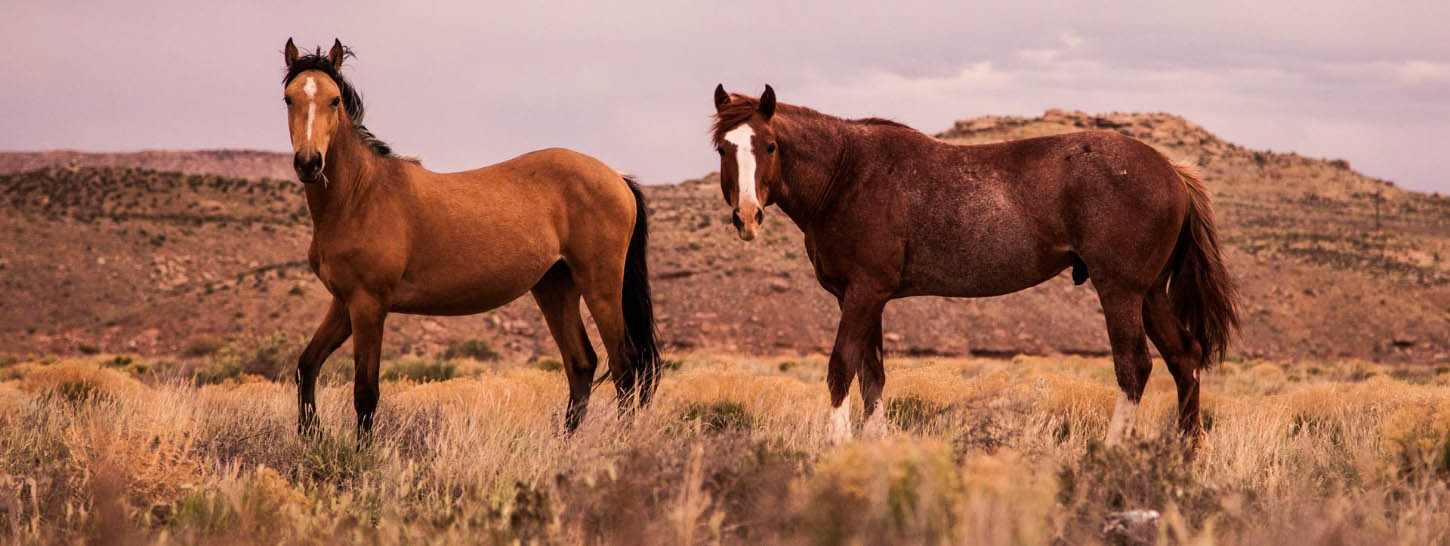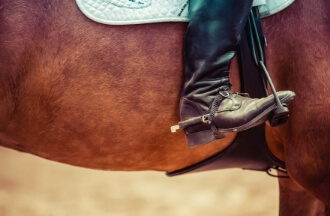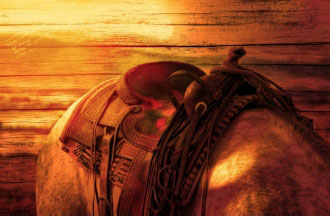
Routine Healthcare For Horses
It is important for a horse keeper to know the normal behaviour and disposition of individual horses in their care and to be able to recognise when something may be wrong. Subtle early signs of ill health are easily missed, yet early detection is essential – the more quickly appropriate remedial care is taken, or treatment applied, the better.
As a matter of routine, every horse should be closely observed and checked daily for signs of injury and ill health. Physical signs and changes in behaviour should be viewed in combination, and considered against what is normal for the individual horse concerned.
Vital signs
Heart or pulse rate, body temperature and respiration frequency (breathing) should be observed at rest, to determine normal levels for each individual horse. Heart and breathing rates vary depending on the age and fitness of the individual, being higher in foals and old horses, and in those that are unfit. In addition, rates naturally increase significantly during exercise and gradually return to normal as the horse recovers – the fitter the horse, the quicker rates will return to normal.
Changes to the normal vital signs, observed at rest, are often key indicators of pain or illness. Normal ranges at rest are as follows.
- Heart or pulse rate of 36 to 42 beats per minute (beats should be clear and regular in strength and frequency)
- Temperature of approximately 38°C (slight variations are normal in response to environmental conditions and ambient temperature)
- Respiration rate of eight to 12 breaths per minute (breaths should be quiet and regular in both depth and frequency)
General health
Ears, eyes and nose
A healthy horse is naturally inquisitive, alert and responsive to its environment. Ears should be either pricked up, flicking backwards and forwards, or when the horse is resting, held softly forward or to each side. Eyes should be bright and clear with a pale pink colour to the skin. The nose should be clean and the breathing steady and regular at rest.
Abnormal aggression, evasion, disinterest or lethargy may indicate that something is wrong. A head held low or pressed into a dark corner of the shelter or stable, with ears clenched back, may indicate more serious ill health or pain.
Thick nasal discharge from one or both nostrils and congested or weeping eyes are also indicators of ill health.
Routine care of your horse should include regular cleansing of the eyes and nostrils with fresh water, using separate (clean) sponges.
Skin and coat
A horse’s skin should be supple and soft, with a natural elasticity. The coat should be smooth and shiny. Dry, flaky skin, a dull coat with hairs raised or excessive grease, can indicate an underlying health problem.
Regular grooming assists in maintaining good coat and skin condition, and can promote good circulation.
Bodily functions
A horse spends much time eating and, each day, drinks from 25 to 55 litres of water. It is normal for the horse to urinate a couple of times daily and pass dung every couple of hours. Dung should be of firm consistency (though its colour and consistency will alter according to the diet), and be covered with a mucus coating.
Loss of appetite, reluctance to eat or drink, excessive thirst, discoloured urine, difficulty passing either urine or droppings and extreme dung consistency (extremely loose or extremely hard), all indicate possible digestive or health problems.
Physical condition
A horse should be well covered with flesh, but not fat. Muscle development, tone and definition will vary according to the type of horse, level of fitness, and the intensity and nature of work.
The neck should be toned and slender, being slightly convex along the top line (but not with a thick and solid crest). The ribs should be able to be felt easily, but should not be overtly visible. The back and quarters should be smoothly covered and lightly rounded, however, the spine should not be prominent (neither should it be evident as a groove over the quarters).
Regular monitoring and maintenance of correct body weight, together with condition-scoring and assessment of fitness will help to identify subtle changes in physical condition. Too little or too much condition (thin or fat) can cause health problems. Sudden changes in body condition may indicate an underlying medical disorder, but could also be a result of incorrect feeding and exercise for the animal’s needs.
Feet and limbs
Most cases of lameness originate in a horse’s foot. If not detected and treated at the outset, minor foot ailments can worsen rapidly, resulting in serious infection or lameness. Daily cleaning and inspection of feet assists in the early detection and prevention of foot problems.
Ideally, a horse should be inspected on a firm, level surface. The horse should walk comfortably and, when standing, the weight should be borne evenly on all four feet. Hooves should be cleaned out, using a hoof pick and hoof brush, with care being taken to remove mud and debris from around the frog and the heels.
Inspect feet daily for:
- impacted stones, thorns or other foreign objects
- abnormal marks or patches of colour (red, purple or dirty black)
- unpleasant smell or discharge
- splits, cracks or other damage to the hoof wall
- twisted or loose shoes
Routine professional hoof care
Hooves should be trimmed and balanced by a registered farrier every four to six weeks for shod horses, and every six to ten weeks for unshod horses.
Teeth
Regular dental care is essential for healthy teeth and gums, to promote normal chewing and good digestion, and acceptance of the bit and rein contact when ridden.
A horse’s mouth contains two main types of teeth – the incisors (cutting teeth) at the front and the molars (grinding teeth) at the back. Both types of teeth are important for normal food intake and proper digestion.
Teeth gradually erupt from the jaw, in response to wear, throughout the animal’s life. Wear is often uneven, leading to sharp edges and hooks developing on the molars (typically on the outside edge in the upper jaw and the inside edge in the lower jaw). Additionally, hooks at the back of the mouth can prevent the normal chewing movement of the jaw, which makes eating difficult.
Sharp edges and hooks can cut into the tongue and cheeks, causing considerable discomfort. Rasping or filing of these protrusions forms an essential part of healthcare. This can be carried out by a veterinary surgeon or a British Equine Veterinary Association (BEVA) approved dental technician. Broken, spilt or decaying teeth may require removal, which must be done by, or under the direction of, a veterinary surgeon.
Identifying possible dental problems
Signs of possible dental problems that may also be signs of other illness are as follows:
- Lack of appetite or reluctance to eat
- Drooling saliva – or a discharge from the mouth or nose
- Sores and swellings around the mouth
- Pain or swellings in the throat and along the jaw line
- Foul smelling breath
- Loss of body condition
Signs of a possible dental problem when eating are as follows:
- Chewing more slowly than normal or favouring one side of the mouth
- Spilling food from the mouth or deliberately dropping (quidding) balls of partially chewed food
- Sores and swellings around the mouth
- Swellings along the jaw-line or cheek
Signs of a possible dental problem when ridden are as follows:
- Aggression or reluctance to be bridled
- Resisting the bit
- Head shaking
- Reluctance to move forward
- Rearing or bolting
Routine professional dental care
The teeth of adult horses should receive routine professional attention at least once per year, even where no specific signs of a problem are observed.
Young horses require more frequent dental inspections, to ensure that the adult teeth come into wear correctly, and to confirm that the milk teeth have been shed successfully.
Older horses also require more frequent dental inspections as they are more prone to dental problems and may suffer from loose or damaged teeth, decay or infections from impacted food.
Back
The term “bad back” is used to describe a range of health problems, such as muscle tension, soreness and bruising, which may be injuries in their own right or indicators of more serious underlying problems.
A horse should be checked regularly from head to tail for signs of tension, soreness or pain.
Signs to look out for that may indicate a back problem are as follows.
- General stiffness when moving, or dragging the hind toes
- Resistance or aggravation when being saddled or the girth is tightened
- Dipping when being mounted
- Hollowing the back or resisting when ridden
- Bucking or bolting
- Stiffness to one side
- Refusal to perform usual tasks, such as cantering or jumping
- Uneven muscle development or tension
- Adverse or exaggerated reaction to touch or pressure
It is advisable to get your horse’s back checked if the animal is exhibiting any of the above signs and also to identify or rule out any of the more probable causes.
A poorly fitting saddle and incorrect riding techniques can lead to a range of back problems in your horse that, if untreated (and the cause not rectified), can create significant discomfort, lasting damage and may result in subsequent poor performance. The most common riding-related problems are seen in the following areas – at the top of the neck, behind the withers, over the back, behind the saddle area and across the pelvis.
Most back problems are the results of a primary issue, for example, a badly fitting saddle. However, the muscles and structures of the neck, back and pelvis can also be injured as a result of an accident (such as a fall while jumping, slipping or stopping suddenly or becoming cast in the stable). It is important for a veterinary surgeon to diagnose the problem and recommend a course of therapy or treatment. The vet should also identify the probable cause, in order to ensure that the condition is not aggravated and to avoid its re-occurrence.
Several therapeutic treatment options may be recommended for a horse that has been diagnosed as having a bad back. In addition to rest, controlled exercise and removing the original cause, the horse may benefit from a course of physical therapy from an approved therapist. Therapies for horses are similar to those for humans, and include physiotherapy, massage therapy, chiropractics and osteopathy.
Horses known to have suffered a back problem may also benefit from an annual check by an approved therapist. Also, every riding horse should have the fit and balance of their saddle checked regularly by a master saddler at least once per year.
The information contained in this leaflet is not intended to replace the advice of a veterinary surgeon, farrier or dental technician for the care and treatment of an individual horse.



